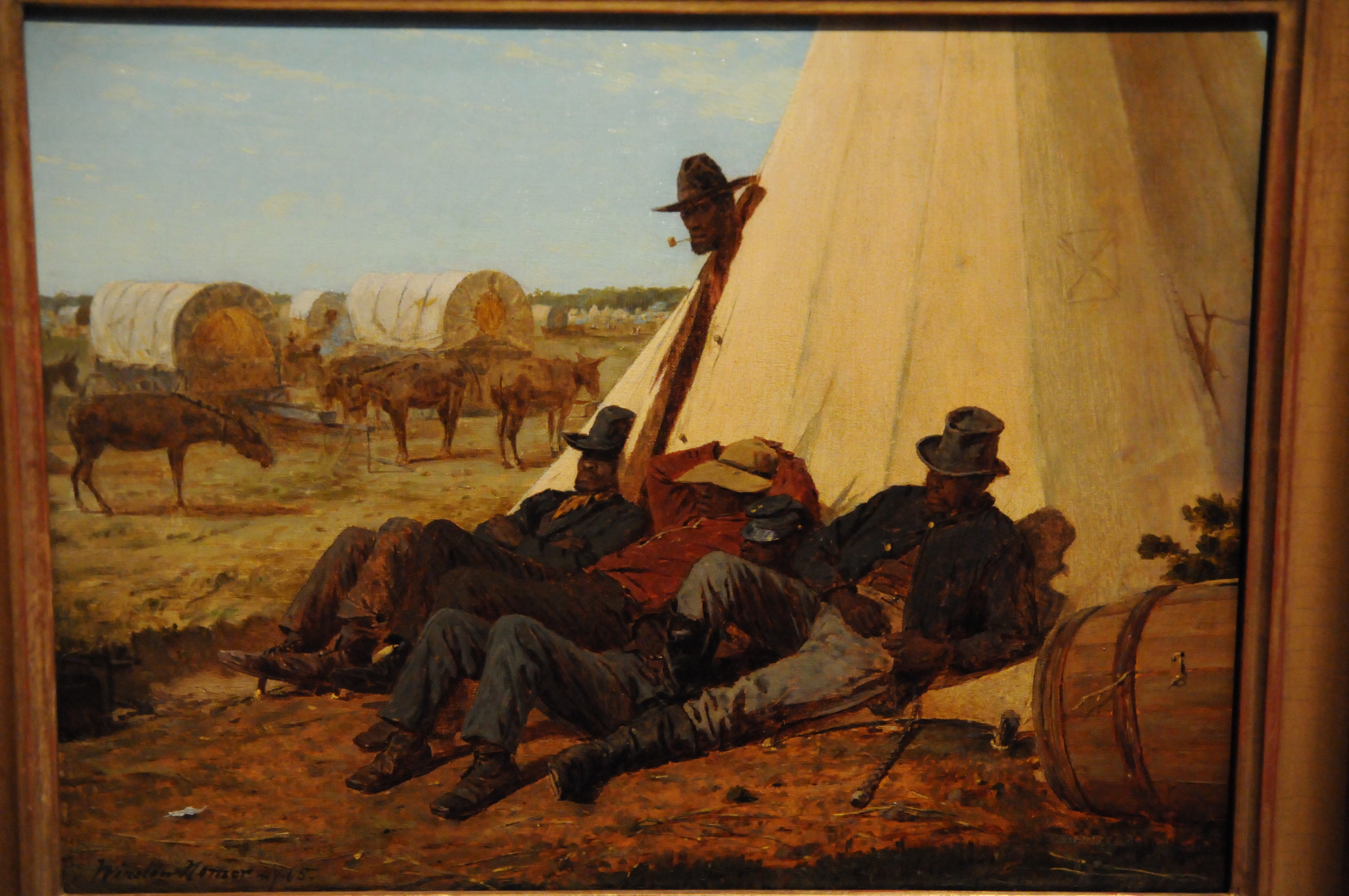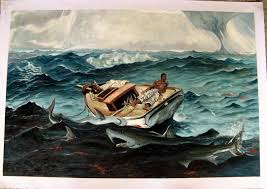
Winslow Homer
From Harvard University Press, on 5 November 2010, "Peter H. Wood on Revisiting Winslow Homer." Peter H. Wood's (Duke University Professor of History, Emeritus) book, titled “Near Andersonville:” Winslow Homer’s Civil War, is an in-depth analysis of a single Homer painting, one that spent nearly a century lost.


Winslow Homer
One hundred years ago—on September 29, 1910, in the early afternoon—the great painter Winslow Homer died at his studio in Prout’s Neck, Maine. I observed this recent centennial anniversary by traveling from my home in Hillsborough, NC, to the nearby North Carolina Museum of Art. After all, I had just finished a book, called Near Andersonville, about one of Homer’s most exciting and least known works.
On that rainy afternoon, I was eager to pay my respects to Homer by revisiting one of his Reconstruction-era oils, Weaning the Calf. It has been a favorite of mine ever since Karen Dalton and I curated a Homer exhibition in 1988. We featured Weaning the Calf in that show, and we wrote about this subtle image in our accompanying volume, Winslow Homer’s Images of Blacks: The Civil War and Reconstruction Years.


The Bright Side - Winslow Homer 1865
It has never been easy to find new things to say about Winslow Homer. When an admiring book about Homer appeared way back in 1914, the author noted that almost everything that could be written about the artist had already been said! Similar comments appeared after Lloyd Goodrich published his “definitive” biography of Homer in 1944.

Winslow Homer

I was disappointed, but not surprised. In 2004, when I published Weathering the Storm: Inside Winslow Homer’s “Gulf Stream,” I had been intrigued by how long the general art community had ignored or downplayed the racial element of that well-known picture from 1899. The famous painting shows a black man adrift on a battered boat, surrounded by sharks. Since that “invisible man” could remain “hidden in plain sight” for so long, why expect more regarding other works?

If The Gulf Stream is Homer’s final and most famous oil depicting an African American figure, Near Andersonville, the subject of my new book, is one of his earliest and least known. But it is also one of his most complex and remarkable black images. Homer finished the picture early in 1866, and it now hangs in the Newark Museum, but it was lost for nearly a century. It was recovered in the early 1960s, in the attic of a New Jersey mansion, thanks to the telling impatience of a junk remover. (source: Harvard University Press)
So, as a lifetime Homer admirer and a historian interested in African America, I was surprised in the 1980s by how little attention had been given to Homer’s impressive paintings of black subjects. Working with Karen Dalton (now at Harvard’s DuBois Institute), I felt we had made a fresh contribution through our exhibition, and I was pleased when the art history community took our arguments seriously.


As I walked into the new building of the NC Museum of Art, I was eager to revisit a favorite painting and commune with its creator. Standing before Weaning the Calf with my rain-soaked cap in hand, I found the picture much as I remembered it. In the central foreground, a black youth (wrapped in shade and his back to the viewer) leads a reluctant calf away from its mother, while two skeptical white boys look on.
Weaning the Calf by Winslow Homer
At one level, it is a simple rural scene. But at another level, as Karen and I tried to make clear more than twenty years ago, it is a rich commentary on Reconstruction-era race relations, part of an array of images created by the former Harper’s illustrator. Abruptly, I was reminded that the wheels of cultural reinterpretation grind slowly here in North Carolina. To my amazement, the wall copy (and the museum website) did not offer any relevant commentary or even mention that the key figure was African American.
Winslow Homer
I was disappointed, but not surprised. In 2004, when I published Weathering the Storm: Inside Winslow Homer’s “Gulf Stream,” I had been intrigued by how long the general art community had ignored or downplayed the racial element of that well-known picture from 1899. The famous painting shows a black man adrift on a battered boat, surrounded by sharks. Since that “invisible man” could remain “hidden in plain sight” for so long, why expect more regarding other works?
If The Gulf Stream is Homer’s final and most famous oil depicting an African American figure, Near Andersonville, the subject of my new book, is one of his earliest and least known. But it is also one of his most complex and remarkable black images. Homer finished the picture early in 1866, and it now hangs in the Newark Museum, but it was lost for nearly a century. It was recovered in the early 1960s, in the attic of a New Jersey mansion, thanks to the telling impatience of a junk remover. (source: Harvard University Press)

Winslow Homer



AFR Dynamics offers the same day emergency repair services at no extra so that you don’t have to go a single day without the comfort you deserve. Our experienced technicians thoroughly assess the A/C systems and provide full-service repair at lower costs.
ReplyDeleteOur Services-
Affordable Air Conditioning Service
Chandler Air Conditioning Service
Glendale AZ Ac Repair Service
Mesa AC services
HVAC repair service
AC repair services
Contact Us
AFR Dynamics
502 E Ingram St.Mesa AZ , 85203
Phone - (480) 275-7535
Website- https://afrdynamics.com
bjc81vwcf
ReplyDeletegolden goose outlet
golden goose outlet
golden goose outlet
golden goose outlet
golden goose outlet
golden goose outlet
golden goose outlet
golden goose outlet
golden goose outlet
golden goose outlet